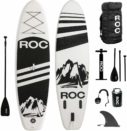Beginners in paddleboarding often have questions regarding the basics. Getting familiar with a new sport is one of the most important things to do before diving straight into it. To this end, we have gathered all the essential questions and answers that most people would like to know about Inflatable SUP’s. So, make sure to take up all the information to make the most of your new sport.
How long does an inflatable SUP take to inflate?
The length of time it takes to inflate your SUP will depend on the type of pump you are using. With a regular hand pump or a K-Pump, it will take anywhere from 4 – 8 minutes. With a good electric pump, it can take 30 seconds to 1 minute.
Is the fin removable?
It depends on the board. Some ISUP’s have a center rear fin that can be removed; on others, the fin is attached. If there are extra smaller fins, they are usually not removable.
Can I take my ISUP on an airplane?
Absolutely. One of the great things about inflatable stand-up paddleboards is that they can be taken anywhere, including on an airplane. They are ideal for traveling as they are very lightweight and compact when deflated.
What PSI do I inflate my board to?
Each board will come with a maximum stated air pressure set by the manufacturer. The PSI for most ISUP’s will range from 10 – 17 PSI with an average at around 14. If you are a lighter person, it is not always necessary to have the board inflated to the maximum air pressure.
I think my board leaks… how do I find it?
Leaks are not that common as most inflatable SUP’s are built tough. However, if you think you might have a tiny leak, there is an easy trick to figure out where it is. With your board fully inflated, pour some soapy water over it and spread the suds with a rag. Watch for tiny bubbles, that’s where your leak will be.
How do I patch my SUP?
Your board will come with a repair kit that includes a small PVC patch and some waterproof glue. Make sure your board is completely dry, then cut a piece from the PVC patch and glue it on. Let it sit for a while – your glue bottle will tell you how long it needs to dry. Then you’re good to go.
How do I care for my ISUP?
There are only a few things you need to do to care for your ISUP properly. Make sure to visit our page dedicated to the cleaning process for ISUP’s in our article “Is it OK to Leave inflatable SUP Inflated?”
What kind of paddle should I use?
SUP paddles can significantly vary in price. Typically the more expensive paddles are lighter and more specific for proper technique and performance.
How long will an inflatable SUP last?
It’s hard to answer that question precisely because it will depend on the amount of use and how well it is taken care of. However, it is a safe bet that your ISUP will last for many, many years to come.
What kind of warranty do ISUP’s have?
The warranty will vary depending on the manufacturer and the quality of the board. On average inflatable SUP’s have a warranty anywhere from 1 – 3 years.
How long does it take to deflate the board and roll it back into its carry bag?
It only takes a few minutes. Let the air out, dry it off with a towel, roll it up, and store it away. It’s pretty simple and takes no time at all.
Can dogs go on an inflatable stand-up paddleboard?
Absolutely. Any dog of any size can go on an ISUP. A larger dog is going to cause more stability issues than a smaller dog, so training before getting on the water is an excellent idea. However, there are no concerns with weight or issues from their claws.
How many people can go on one board?
Usually, it’s one person per board. However, it’s no problem to add a child or two or another adult if you like. Check the weight requirement for your particular SUP before loading it up, but most of them can hold quite a bit of weight.
Can I store my inflatable SUP outside?
It is recommended that you store your ISUP in a dry, cool place away from exposure to the elements.
How stable are inflatable SUP’s?
They are great for beginners, for kids, for dogs, and for traveling. Although stability can vary depending on the shape, width, and depth of the board, a general rule is that they are all reasonably stable. The thicker 6” boards will be the most stable and able to support more weight with no flex whatsoever.





